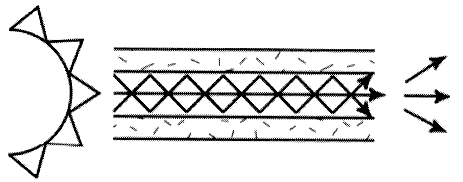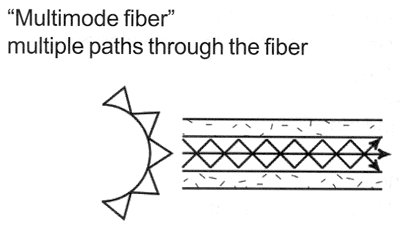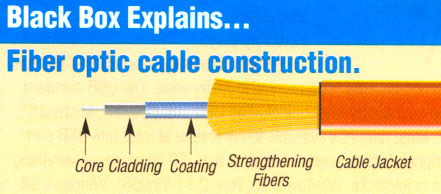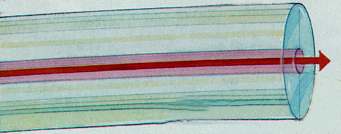THE BASICS OF FIBER OPTIC CABLE
(Single-mode multi-mode)
a Tutorial

BRIEF OVER VIEW OF FIBER OPTIC CABLE ADVANTAGES OVER COPPER:
• SPEED: Fiber optic networks operate at high
speeds - up into the gigabits
• BANDWIDTH: large carrying capacity
• DISTANCE: Signals can be transmitted further
without needing to be "refreshed" or strengthened.
• RESISTANCE: Greater resistance to electromagnetic
noise such as radios, motors or other nearby cables.
• MAINTENANCE: Fiber optic cables costs much less to
maintain.
In recent years it has become apparent that fiber-optics are steadily replacing
copper wire as an appropriate means of communication signal transmission. They
span the long distances between local phone systems as well as providing the
backbone for many network systems. Other system users include cable television
services, university campuses, office buildings, industrial plants, and electric
utility companies.
A fiber-optic system is similar to the copper wire system
that fiber-optics is replacing. The difference is that fiber-optics use light
pulses to transmit information down fiber lines instead of using electronic
pulses to transmit information down copper lines. Looking at the components in a
fiber-optic chain will give a better understanding of how the system works in
conjunction with wire based systems.
At one end of the system is a transmitter. This is the
place of origin for information coming on to fiber-optic lines. The transmitter
accepts coded electronic pulse information coming from copper wire. It then
processes and translates that information into equivalently coded light pulses.
A light-emitting diode (LED) or an injection-laser diode (ILD) can be used for
generating the light pulses. Using a lens, the light pulses are funneled into
the fiber-optic medium where they travel down the cable. The light (near
infrared) is most often 850nm for shorter distances and 1,300nm for longer
distances on Multi-mode fiber and 1300nm for single-mode fiber and 1,500nm is
used for for longer distances.
Think of a fiber cable in terms of very long cardboard
roll (from the inside roll of paper towel) that is coated with a mirror on the
inside.
If you shine a flashlight in one end you can see light come out at the far end - even if it's
been bent
around a corner.
Light pulses move easily down the fiber-optic line because
of a principle known as total internal reflection. "This principle of total
internal reflection states that when the angle of incidence exceeds a critical
value, light cannot get out of the glass; instead, the light bounces back in.
When this principle is applied to the construction of the fiber-optic strand, it
is possible to transmit information down fiber lines in the form of light
pulses. The core must a very clear and pure material for the light or in most
cases near infrared light (850nm, 1300nm and 1500nm). The core can be Plastic
(used for very short distances) but most are made from glass. Glass optical
fibers are almost always made from pure
silica, but some other materials, such as
fluorozirconate,
fluoroaluminate, and
chalcogenide glasses, are used for longer-wavelength infrared applications.
There are three types of fiber optic cable commonly used: single mode,
multimode and plastic optical fiber (POF).
Transparent glass or plastic fibers which allow light to be guided from one end to the other with minimal loss.


Fiber optic cable functions as a "light guide,"
guiding the light introduced at one end of the cable through to
the other end. The light source can either be a light-emitting
diode (LED)) or a laser.
The light source is pulsed on and off, and a light-sensitive
receiver on the other end of the cable converts the pulses back
into the digital ones and zeros of the original signal.
Even laser light shining through a fiber optic cable is
subject to loss of strength, primarily through dispersion and
scattering of the light, within the cable itself. The faster the
laser fluctuates, the greater the risk of dispersion. Light
strengtheners, called repeaters, may be necessary to refresh the
signal in certain applications.
While fiber optic cable itself has become cheaper over
time - a equivalent
length of copper cable cost less per foot but not in capacity. Fiber optic cable connectors and the
equipment needed to install them are still more expensive than their
copper counterparts.
Single Mode cable is a single stand
(most applications use 2 fibers) of glass fiber with a
diameter of 8.3 to 10 microns that has one mode of transmission.
Single Mode Fiber with a relatively narrow diameter, through which only one mode
will propagate typically 1310 or 1550nm. Carries higher bandwidth than multimode fiber, but requires a
light source with a narrow spectral width. Synonyms mono-mode optical fiber,
single-mode fiber, single-mode optical waveguide, uni-mode fiber.
Single Modem fiber is used in many applications where data
is sent at multi-frequency (WDM Wave-Division-Multiplexing) so only one cable is
needed - (single-mode on one single fiber)
Single-mode
fiber gives you a higher transmission rate and up to 50 times more distance than
multimode, but it also costs more. Single-mode fiber has a much smaller core
than multimode. The small core and single light-wave virtually
eliminate any distortion that could result from overlapping light pulses,
providing the least signal attenuation and the highest transmission speeds of
any fiber cable type.
Single-mode optical fiber is an optical fiber in which only the lowest order
bound mode can propagate at the wavelength of interest typically 1300 to 1320nm.

jump to single mode fiber
page
Multi-Mode cable has a little bit bigger
diameter,
with a common diameters in the 50-to-100 micron range for the light carry component
(in the US the most common size is 62.5um). Most applications in which
Multi-mode fiber is used, 2 fibers are used (WDM is not normally used on
multi-mode fiber). POF is a newer plastic-based cable which promises performance similar to
glass cable on very short runs, but at a lower cost.
Multimode fiber
gives you high bandwidth at high speeds (10 to 100MBS - Gigabit to 275m to 2km) over medium distances. Light waves are
dispersed into numerous paths, or modes, as they travel through the cable's core
typically 850 or 1300nm. Typical multimode fiber core diameters are 50, 62.5, and 100 micrometers.
However, in long cable runs (greater than 3000 feet [914.4 meters), multiple paths
of light can cause signal distortion at the receiving end, resulting in an
unclear and incomplete data transmission so designers now call for single mode
fiber in new applications using Gigabit and beyond.



The use of fiber-optics was generally not available until 1970 when Corning
Glass Works was able to produce a fiber with a loss of 20 dB/km. It was
recognized that optical fiber would be feasible for telecommunication
transmission only if glass could be developed so pure that attenuation would be
20dB/km or less. That is, 1% of the light would remain after traveling 1 km.
Today's optical fiber attenuation ranges from 0.5dB/km to 1000dB/km depending on
the optical fiber used. Attenuation limits are based on intended application.
The applications of optical fiber communications have increased at a rapid
rate, since the first commercial installation of a fiber-optic system in 1977.
Telephone companies began early on, replacing their old copper wire systems with
optical fiber lines. Today's telephone companies use optical fiber throughout
their system as the backbone architecture and as the long-distance connection
between city phone systems.
Cable television companies have also began integrating fiber-optics into
their cable systems. The trunk lines that connect central offices have generally
been replaced with optical fiber. Some providers have begun experimenting with
fiber to the curb using a fiber/coaxial hybrid. Such a hybrid allows for the
integration of fiber and coaxial at a neighborhood location. This location,
called a node, would provide the optical receiver that converts the light
impulses back to electronic signals. The signals could then be fed to individual
homes via coaxial cable.
Local Area Networks (LAN) is a collective group of computers, or computer
systems, connected to each other allowing for shared program software or data
bases. Colleges, universities, office buildings, and industrial plants, just to
name a few, all make use of optical fiber within their LAN systems.
Power companies are an emerging group that have begun to utilize fiber-optics
in their communication systems. Most power utilities already have fiber-optic
communication systems in use for monitoring their power grid systems.
jump to
Illustrated Fiber Optic
Glossary pages
Fiber
by John MacChesney - Fellow at
Bell Laboratories, Lucent Technologies
Some 10 billion digital bits can
be transmitted per second along an optical fiber link in a
commercial network, enough to carry tens of thousands of
telephone calls. Hair-thin fibers consist of two concentric
layers of high-purity silica glass the core and the cladding,
which are enclosed by a protective sheath. Light rays modulated
into digital pulses with a laser or a light-emitting diode move
along the core without penetrating the cladding.
The light stays confined to the
core because the cladding has a lower refractive index—a
measure of its ability to bend light. Refinements in optical
fibers, along with the development of new lasers and diodes, may
one day allow commercial fiber-optic networks to carry trillions
of bits of data per second.
Total internal refection
confines light within optical fibers (similar to looking down a
mirror made in the shape of a long paper towel tube). Because the
cladding has a lower refractive index, light rays reflect back
into the core if they encounter the cladding at a shallow angle
(red lines). A ray that exceeds a certain "critical"
angle escapes from the fiber (yellow line).

STEP-INDEX MULTIMODE FIBER
has a large core, up to 100 microns in diameter. As a result,
some of the light rays that make up the digital pulse may travel
a direct route, whereas others zigzag as they bounce off the
cladding. These alternative pathways cause the different
groupings of light rays, referred to as modes, to arrive
separately at a receiving point. The pulse, an aggregate of
different modes, begins to spread out, losing its well-defined
shape. The need to leave spacing between pulses to prevent
overlapping limits bandwidth that is, the amount of information
that can be sent. Consequently, this type of fiber is best suited
for transmission over short distances, in an endoscope, for
instance.

GRADED-INDEX MULTIMODE FIBER
contains a core in which the refractive index diminishes
gradually from the center axis out toward the cladding. The
higher refractive index at the center makes the light rays moving
down the axis advance more slowly than those near the cladding.
Also, rather than zigzagging off the cladding, light in the core
curves helically because of the graded index, reducing its travel
distance. The shortened path and the higher speed allow light at
the periphery to arrive at a receiver at about the same time as
the slow but straight rays in the core axis. The result: a
digital pulse suffers less dispersion.
SINGLE-MODE FIBER has a narrow
core (eight microns or less), and the index of refraction between
the core and the cladding changes less than it does for multimode
fibers. Light thus travels parallel to the axis, creating little
pulse dispersion. Telephone and cable television networks install
millions of kilometers of this fiber every year.

BASIC
CABLE DESIGN
1 - Two basic
cable designs are:
Loose-tube cable, used in
the majority of outside-plant installations in North America, and
tight-buffered cable, primarily used inside buildings.
The modular design of
loose-tube cables typically holds up to 12 fibers per buffer tube
with a maximum per cable fiber count of more than 200 fibers.
Loose-tube cables can be all-dielectric or optionally armored.
The modular buffer-tube design permits easy drop-off of groups of
fibers at intermediate points, without interfering with other
protected buffer tubes being routed to other locations. The
loose-tube design also helps in the identification and
administration of fibers in the system.
Single-fiber
tight-buffered cables are used as pigtails, patch cords and
jumpers to terminate loose-tube cables directly into
opto-electronic transmitters, receivers and other active and
passive components.
Multi-fiber tight-buffered
cables also are available and are used primarily for alternative
routing and handling flexibility and ease within buildings.
In a loose-tube cable
design, color-coded plastic buffer tubes house and protect
optical fibers. A gel filling compound impedes water penetration.
Excess fiber length (relative to buffer tube length) insulates
fibers from stresses of installation and environmental loading.
Buffer tubes are stranded around a dielectric or steel central
member, which serves as an anti-buckling element.
The cable core, typically uses aramid yarn,
as the primary tensile strength
member. The outer polyethylene jacket is extruded over the core.
If armoring is required, a corrugated steel tape is formed around
a single jacketed cable with an additional jacket extruded over
the armor.
Loose-tube cables
typically are used for outside-plant installation in aerial, duct
and direct-buried applications.
With tight-buffered cable
designs, the buffering material is in direct contact with the
fiber. This design is suited for "jumper cables" which
connect outside plant cables to terminal equipment, and also for
linking various devices in a premises network.
Multi-fiber,
tight-buffered cables often are used for intra-building, risers,
general building and plenum applications.
The tight-buffered design
provides a rugged cable structure to protect individual fibers
during handling, routing and connectorization. Yarn strength
members keep the tensile load away from the fiber.
As with loose-tube cables,
optical specifications for tight-buffered cables also should
include the maximum performance of all fibers over the operating
temperature range and life of the cable. Averages should not be
acceptable.
Connector Types

Gruber Industries
cable connectors
here are some common fiber
cable types
What's the best way to terminate fiber optic cable? That
depends on the application, cost considerations and your own personal
preferences. The following connector comparisons can make the decision
easier.
Epoxy & Polish
Epoxy & polish style connectors were the original fiber optic connectors.
They still represent the largest segment of connectors, in both quantity
used and variety available. Practically every style of connector is
available including ST, SC, FC, LC, D4, SMA, MU, and MTRJ. Advantages
include:
• Very robust. This connector style is based on tried and true technology,
and can withstand the greatest environmental and mechanical stress when
compared to the other connector technologies.
• This style of connector accepts the widest assortment of cable jacket
diameters. Most connectors of this group have versions to fit onto 900um
buffered fiber, and up to 3.0mm jacketed fiber.
• Versions are. available that hold from 1 to 24 fibers in a single
connector.
Installation Time: There is an initial setup time for the field technician
who must prepare a workstation with polishing equipment and an epoxy-curing
oven. The termination time for one connector is about 25 minutes due to the
time needed to heat cure the epoxy. Average time per connector in a large
batch can be as low as 5 or 6 minutes. Faster curing epoxies such as
anaerobic epoxy can reduce the installation time, but fast cure epoxies are
not suitable for all connectors.
Skill Level: These connectors, while not difficult to install, do require
the most supervised skills training, especially for polishing. They are best
suited for the high-volume installer or assembly house with a trained and
stable work force.
Costs: Least expensive connectors to purchase, in many cases being 30 to 50
percent cheaper than other termination style connectors. However, factor in
the cost of epoxy curing and ferrule polishing equipment, and their
associated consumables.
Pre-Loaded Epoxy or No-Epoxy & Polish
There are two main categories of no-epoxy & polish connectors. The first are
connectors that are pre-loaded with a measured amount of epoxy. These
connectors reduce the skill level needed to install a connector but they
don't significantly reduce the time or equipment need-ed. The second
category of connectors uses no epoxy at all. Usually they use an internal
crimp mechanism to stabilize the fiber. These connectors reduce both the
skill level needed and installation time. ST, SC, and FC connector styles
are available. Advantages include:
• Epoxy injection is not required.
• No scraped connectors due to epoxy over-fill.
• Reduced equipment requirements for some versions.
Installation Time: Both versions have short setup time, with pre-loaded
epoxy connectors having a slightly longer setup. Due to curing time, the
pre-loaded epoxy connectors require the same amount of installation time as
standard connectors, 25 minutes for 1 connector, 5-6 minutes average for a
batch. Connectors that use the internal crimp method install in 2 minutes or
less.
Skill Level: Skill requirements are reduced because the crimp mechanism is
easier to master than using epoxy. They provide maximum flexibility with one
technology and a balance between skill and cost.
Costs: Moderately more expensive to purchase than a standard connector.
Equipment cost is equal to or less than that of standard con¬nectors.
Consumable cost is reduced to polish film and cleaning sup-plies. Cost
benefits derive from reduced training requirements and fast installation
time.
No-Epoxy & No-Polish
Easiest and fastest connectors to install; well suited for contractors who
cannot cost-justify the training and supervision required for standard
connectors. Good solution for fast field restorations. ST, SC, FC, LC, and
MTRJ connector styles are available. Advantages include:
• No setup time required.
• Lowest installation time per connector.
• Limited training required.
• Little or no consumables costs.
Installation Time: Almost zero. Its less than 1 minute regardless of number
of connectors.
Skill level: Requires minimal training, making this type of connector ideal
for installation companies with a high turnover rate of installers and/or
that do limited amounts of optical-fiber terminations.
Costs: Generally the most expensive style connector to purchase, since some
of the labor (polishing) is done in the factory. Also, one or two fairly
expensive installation tools may be required. However, it may still be less
expensive on a cost-per-installed-connector basis due to lower labor cost. |
jump to
Calculating fiber loss and
distance
jump to
related
fiber optic equipment pages
jump to
Telebyte
Fiber tutorial pages
(very good write up)
2.
The Fiber Optic Data Communications Link For the Premises Environment
2.1
The Fiber Optic data Communications Link, End-to-End
2.2
Fiber Optic Cable
2.3
Transmitter
2.4
Receiver
2.5
Connectors
2.6
Splicing
2.7
Analyzing Performance of a Link
jump to
The Complete Telebyte
Fiber tutorial pages
ARC Electronics
301-924-7400 EXT 25
arc@arcelect.com







